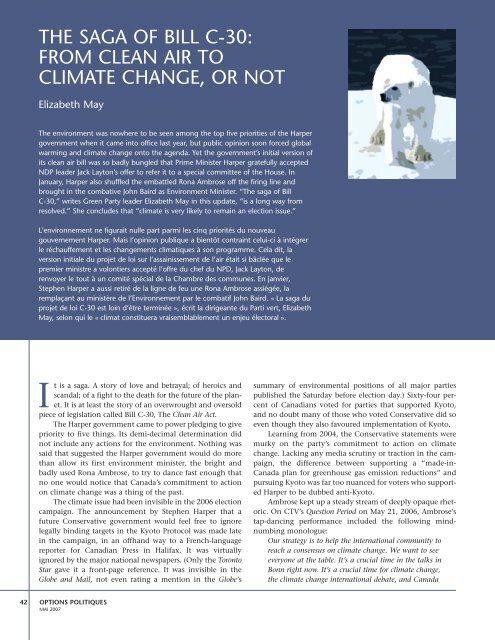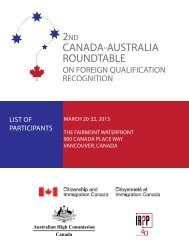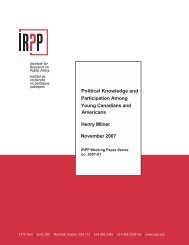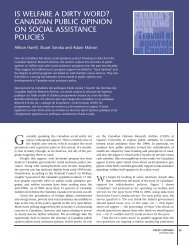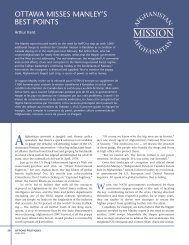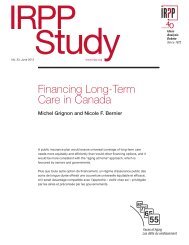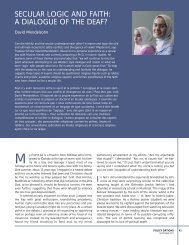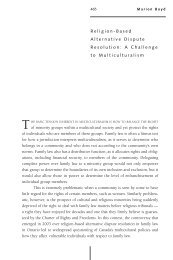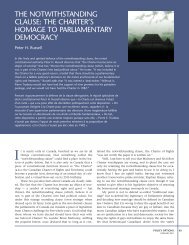THE SAGA OF BILL C-30: FROM CLEAN AIR TO CLIMATE ...
THE SAGA OF BILL C-30: FROM CLEAN AIR TO CLIMATE ...
THE SAGA OF BILL C-30: FROM CLEAN AIR TO CLIMATE ...
Create successful ePaper yourself
Turn your PDF publications into a flip-book with our unique Google optimized e-Paper software.
42<br />
<strong>THE</strong> <strong>SAGA</strong> <strong>OF</strong> <strong>BILL</strong> C-<strong>30</strong>:<br />
<strong>FROM</strong> <strong>CLEAN</strong> <strong>AIR</strong> <strong>TO</strong><br />
<strong>CLIMATE</strong> CHANGE, OR NOT<br />
Elizabeth May<br />
The environment was nowhere to be seen among the top five priorities of the Harper<br />
government when it came into office last year, but public opinion soon forced global<br />
warming and climate change onto the agenda. Yet the government’s initial version of<br />
its clean air bill was so badly bungled that Prime Minister Harper gratefully accepted<br />
NDP leader Jack Layton’s offer to refer it to a special committee of the House. In<br />
January, Harper also shuffled the embattled Rona Ambrose off the firing line and<br />
brought in the combative John Baird as Environment Minister. “The saga of Bill<br />
C-<strong>30</strong>,” writes Green Party leader Elizabeth May in this update, “is a long way from<br />
resolved.” She concludes that “climate is very likely to remain an election issue.”<br />
L’environnement ne figurait nulle part parmi les cinq priorités du nouveau<br />
gouvernement Harper. Mais l’opinion publique a bientôt contraint celui-ci à intégrer<br />
le réchauffement et les changements climatiques à son programme. Cela dit, la<br />
version initiale du projet de loi sur l’assainissement de l’air était si bâclée que le<br />
premier ministre a volontiers accepté l’offre du chef du NPD, Jack Layton, de<br />
renvoyer le tout à un comité spécial de la Chambre des communes. En janvier,<br />
Stephen Harper a aussi retiré de la ligne de feu une Rona Ambrose assiégée, la<br />
remplaçant au ministère de l’Environnement par le combatif John Baird. « La saga du<br />
projet de loi C-<strong>30</strong> est loin d’être terminée », écrit la dirigeante du Parti vert, Elizabeth<br />
May, selon qui le « climat constituera vraisemblablement un enjeu électoral ».<br />
It is a saga. A story of love and betrayal; of heroics and<br />
scandal; of a fight to the death for the future of the planet.<br />
It is at least the story of an overwrought and oversold<br />
piece of legislation called Bill C-<strong>30</strong>, The Clean Air Act.<br />
The Harper government came to power pledging to give<br />
priority to five things. Its demi-decimal determination did<br />
not include any actions for the environment. Nothing was<br />
said that suggested the Harper government would do more<br />
than allow its first environment minister, the bright and<br />
badly used Rona Ambrose, to try to dance fast enough that<br />
no one would notice that Canada’s commitment to action<br />
on climate change was a thing of the past.<br />
The climate issue had been invisible in the 2006 election<br />
campaign. The announcement by Stephen Harper that a<br />
future Conservative government would feel free to ignore<br />
legally binding targets in the Kyoto Protocol was made late<br />
in the campaign, in an offhand way to a French-language<br />
reporter for Canadian Press in Halifax. It was virtually<br />
ignored by the major national newspapers. (Only the Toronto<br />
Star gave it a front-page reference. It was invisible in the<br />
Globe and Mail, not even rating a mention in the Globe’s<br />
OPTIONS POLITIQUES<br />
MAI 2007<br />
summary of environmental positions of all major parties<br />
published the Saturday before election day.) Sixty-four percent<br />
of Canadians voted for parties that supported Kyoto,<br />
and no doubt many of those who voted Conservative did so<br />
even though they also favoured implementation of Kyoto.<br />
Learning from 2004, the Conservative statements were<br />
murky on the party’s commitment to action on climate<br />
change. Lacking any media scrutiny or traction in the campaign,<br />
the difference between supporting a “made-in-<br />
Canada plan for greenhouse gas emission reductions” and<br />
pursuing Kyoto was far too nuanced for voters who supported<br />
Harper to be dubbed anti-Kyoto.<br />
Ambrose kept up a steady stream of deeply opaque rhetoric.<br />
On CTV’s Question Period on May 21, 2006, Ambrose’s<br />
tap-dancing performance included the following mindnumbing<br />
monologue:<br />
Our strategy is to help the international community to<br />
reach a consensus on climate change. We want to see<br />
everyone at the table. It’s a crucial time in the talks in<br />
Bonn right now. It’s a crucial time for climate change,<br />
the climate change international debate, and Canada
has come to the table with a<br />
belief and a position that we<br />
need to see everyone at the<br />
table. We need to emerge from<br />
these talks with a comprehensive<br />
and an inclusive approach<br />
that includes all countries.<br />
That is what that document<br />
shows, and actually that document,<br />
Jane, was a draft document<br />
that ended up being our<br />
public document that’s posted<br />
on the United Nations website.<br />
So we’ve always been transparent<br />
about how we feel. The<br />
Prime Minister has been clear<br />
that we feel very strongly that<br />
all countries have to contribute<br />
to this global problem. And<br />
Canada’s ready to contribute<br />
and we want to see all countries<br />
at the table.<br />
Deciphering the above requires<br />
recourse to the ultimate authority<br />
in bafflegab and nonsense, Lewis<br />
Carroll. For a plain explanation of<br />
Harper’s climate policy, viewers might<br />
as well have heard “Twas brillig and<br />
the slithy toves did gyre and gimble in<br />
the wabe.”<br />
The public was not deluded by the<br />
doublespeak, and Prime Minister<br />
Harper and his inner team realized an<br />
environmental initiative was required.<br />
By summer, the Harper government<br />
was making noises about a new initiative<br />
to tackle clean air. The first touted<br />
effort was described as “Green Plan 2.”<br />
This raised hopes of a serious follow-up<br />
The saga of Bill C-<strong>30</strong>: from clean air to climate change, or not<br />
to the Mulroney Green Plan of the early<br />
1990s. Revisiting the Green Plan,<br />
brought forward by then environment<br />
minister Jean Charest, would have been<br />
a good foundation for Harper’s environmental<br />
policy. Much that was good in<br />
that plan had been lost through Liberal<br />
budget cut-backs and neglect.<br />
The public was not deluded by the doublespeak, and Prime<br />
Minister Harper and his inner team realized an environmental<br />
initiative was required. By summer, the Harper government<br />
was making noises about a new initiative to tackle clean air.<br />
The first touted effort was described as “Green Plan 2.” This<br />
raised hopes of a serious follow-up to the Mulroney Green<br />
Plan of the early 1990s. Revisiting the Green Plan, brought<br />
forward by Environment Minister Jean Charest, would have<br />
been a good foundation for Harper’s environmental policy.<br />
Much that was good in that plan had been lost through<br />
Liberal budget cutbacks and neglect.<br />
For example, the cancellation of<br />
the State of the Environment report,<br />
launched by the Mulroney government<br />
and cancelled by the Chrétien government,<br />
reduced fundamental information<br />
that guided policy. This report<br />
relied on solid data collection, much of<br />
which has also been cancelled, to pull<br />
together an authoritative, publicly<br />
accessible report on Canadian progress<br />
in meeting environmental indicators.<br />
When it was cancelled, Alberta commentator<br />
Andrew Nikiforuk compared<br />
it to a blind man selling his guide dog<br />
as a cost-cutting measure.<br />
That said, it must be noted that<br />
the Mulroney Green Plan has<br />
increased in lustre particularly in hindsight<br />
due to the poor performance of<br />
governments since. The reality is that<br />
the first Green Plan was more a fund<br />
than a plan.<br />
A revised and updated Green Plan<br />
2 would have been a sensible approach,<br />
but as the weeks wore by, Ambrose,<br />
appearing before a parliamentary committee,<br />
began the process of lowering<br />
expectations. It would not, she said, be<br />
as much a “plan” as an “approach.”<br />
In Vancouver, in early October, the<br />
Prime Minister assembled a photo op<br />
in which he announced that a new bill<br />
would emerge soon. The Prime<br />
Minister promised a Clean Air Act, but<br />
provided no details. He took a swipe at<br />
Kyoto, bragging that his new plan was<br />
not developed in an “exotic location.”<br />
He dragged Environment Minister<br />
Rona Ambrose, Natural Resources<br />
Minister Gary Lunn and Health<br />
Minister Tony Clement to<br />
Vancouver, where they participated<br />
in the press conference<br />
without being allowed<br />
to speak. As Don Martin<br />
quipped in the National<br />
Post, they filled the role usually<br />
played by potted palms,<br />
arrayed in a tasteful semicircle<br />
behind their boss.<br />
By the time Minister<br />
Ambrose announced the<br />
Clean Air Act, at a briefing<br />
interrupted by a fire alarm<br />
in Centre Block, allowing<br />
reporters a breath of actual fresh air as<br />
Ambrose stumbled through her presentation,<br />
it was the most overhyped<br />
legislation in Canadian environmental<br />
law history. This alone is really quite<br />
an accomplishment, Canadian green<br />
rhetoric usually exceeding substance.<br />
Rather than being a new Act, it was,<br />
in fact, a set of amendments to Canada’s<br />
existing Canadian Environmental Protection<br />
Act. That Act had in 1986, when first<br />
unveiled, been described by the environment<br />
minister as the strongest environmental<br />
law in the Western hemisphere. It<br />
wasn’t, but it was surely more than adequate,<br />
without amendment, to meet the<br />
stated goals of Minister Ambrose and<br />
Prime Minister Harper.<br />
When revealed, Bill C-<strong>30</strong> was certainly<br />
underwhelming. It was,<br />
as noted, not a new piece of legislation,<br />
but a set of amendments to the<br />
existing CEPA.<br />
In addition to the legislative<br />
amendments, there was also a notice of<br />
intent to regulate. It was in the notice of<br />
intent that the Harper government’s first<br />
and, to this date, only greenhouse gas<br />
reduction target was revealed. While<br />
Kyoto targets are set against a 1990 baseline<br />
of emissions, the Harper<br />
POLICY OPTIONS<br />
MAY 2007<br />
43
44<br />
Elizabeth May<br />
government moved into a unique<br />
stance, gauging emissions reductions<br />
against 2003 levels. With this deft sleight<br />
of hand, its goals started against a baseline<br />
20 percent higher than that of any<br />
other government in the world. While<br />
Kyoto pledges reductions of 6 percent<br />
below 1990 levels and scientists urge<br />
reductions of <strong>30</strong> percent below 1990 by<br />
2020, leading to 80 percent below 1990<br />
by 2050, the Harper target was 45 to 65<br />
percent below 2003 levels by 2050.<br />
Many in the media latched on to the<br />
absurdity of the year 2050 as the target.<br />
However, what was far more worrying<br />
was that the 2050 goal when translated<br />
into the base year used by the rest of the<br />
world became a goal for massive sea level<br />
rise and dangerous climate instability. By<br />
2050, Harper’s government<br />
would have had us achieve the<br />
levels of reductions now understood<br />
to be urgent by 2020.<br />
The Bill itself, as it stood on<br />
first reading, represented a substantial<br />
threat to the federal<br />
government’s ability to regulate<br />
greenhouse gases and air pollution.<br />
That reality was entirely<br />
missed by media coverage, and<br />
requires some explanation.<br />
T he<br />
existing CEPA contained<br />
all the legislative powers<br />
required by a government to meet the<br />
goals of reducing air pollution and meeting<br />
Kyoto targets. What is more, the<br />
existing legislation has already faced a<br />
constitutional challenge that went all the<br />
way to the Supreme Court of Canada.<br />
Hydro-Québec had challenged the constitutional<br />
purview of the federal government<br />
to regulate toxic substances in the<br />
face of a federal regulation within CEPA<br />
to control PCBs. In the majority opinion,<br />
Justice Gerald LaForest had ruled that the<br />
concern for toxic substances was a legitimate<br />
matter of national concern, and the<br />
law withstood the challenge. Part 5 of the<br />
Act allowed for “toxic” to be defined in a<br />
fashion well beyond a lay understanding<br />
of something poisonous. It also included<br />
any substance that, when released into<br />
the environment in sufficient quantities,<br />
could cause serious or irreversible envi-<br />
OPTIONS POLITIQUES<br />
MAI 2007<br />
ronmental damage. In that context,<br />
greenhouse gases met the definition of<br />
“CEPA toxic.”<br />
The use of the word “toxic” to<br />
describe greenhouse gases had<br />
proven controversial and delayed<br />
action in the previous government. As<br />
then Conservative environment critic<br />
Bob Mills had argued, babies exhale<br />
carbon dioxide. “Are we to conclude<br />
that baby’s breath is toxic?” Industry<br />
groups had long lobbied to change the<br />
nomenclature for fear that otherwise<br />
non-toxic regulated substances would<br />
be labelled “toxic,” which would hurt<br />
their trade in commerce.<br />
In the spring of 2005, Environment<br />
Minister Stéphane Dion had decided to<br />
In the fall of 2005, Dion succeeded<br />
in taking the first step to regulate<br />
GHGs in Canada. He added the six<br />
GHG chemicals to schedule A of<br />
CEPA. As CEPA works one chemical at<br />
a time, through scheduling and then<br />
regulating, the Act was completely<br />
primed to enforce binding<br />
reductions on GHGs at the very<br />
moment the Martin government fell.<br />
regulate GHGs using CEPA. In order to<br />
avoid the perception problem around<br />
the word “toxic,” the government of<br />
the day attached the permission to regulate<br />
GHGs under CEPA, while amending<br />
the Act to remove the word “toxic,”<br />
to the budget implementation bill. It<br />
was audacious and designed to get regulations<br />
in place for greenhouse gases.<br />
And it nearly brought down Paul<br />
Martin’s minority government.<br />
The leader of the official opposition,<br />
Stephen Harper, savaged the tying<br />
of amending CEPA and regulating GHGs<br />
to a budget implementation bill. And, in<br />
a strange twist, the media reported he<br />
was aided by environmental groups.<br />
The environmental movement<br />
had split over the proposal. Those<br />
groups focusing their work on climate<br />
change thought the approach was<br />
acceptable and that anything that<br />
moved GHGs to speedy regulation was<br />
a good idea. Those groups working on<br />
toxic chemical regulation were outraged,<br />
believing that any effort to<br />
remove the word “toxic” was part of an<br />
industry plot and must be vigorously<br />
opposed. As head of the Sierra Club at<br />
the time, I wrote to the Globe and Mail<br />
and suggested that the environmental<br />
groups’ criticism constituted “friendly<br />
fire” and should not be lumped in with<br />
Harper’s efforts to block action to regulate<br />
GHGs. Sadly, the effort to regulate<br />
within the budget implementation bill<br />
was stillborn. As the budget implementation<br />
bill was clearly a “money bill,”<br />
the vote would be one of confidence,<br />
and its defeat would have brought<br />
down the government. The<br />
GHG regulation and CEPA<br />
amendment sections were<br />
removed.<br />
As regulations of GHGs for<br />
those large industries strangely<br />
known in the governmental<br />
lexicon as “large final emitters”<br />
was a part of Dion’s “Project<br />
Green” (a belated and weak climate<br />
plan that was the best<br />
thing offered in a dozen years<br />
of non-plans), Dion resolved to<br />
move ahead with regulations,<br />
regardless of the presence of<br />
the word “toxic” in the definition.<br />
In the fall of 2005, Dion succeeded<br />
in taking the first step to regulate<br />
GHGs in Canada. He added the six<br />
GHG chemicals to schedule A of CEPA.<br />
As CEPA works one chemical at a time,<br />
through scheduling and then regulating,<br />
the Act was completely primed to<br />
enforce binding reductions on GHG at<br />
the very moment the Martin government<br />
fell.<br />
In order to regulate GHGs, no new<br />
legislative powers were required. There<br />
was no need for a new Act.<br />
Strangely, the new Act removed air<br />
pollution and GHGs from the safe, pretested,<br />
Supreme-Court-approved part 5<br />
of the Act, and added a part 5.1, dumping<br />
all air pollutants and GHGs in the<br />
new section and absurdly referring to a<br />
new part 5.1 as a “clean air act.”
The new Act was further vulnerable<br />
to a future court challenge through its<br />
poor drafting. The definition section<br />
split GHGs apart from air pollution,<br />
clearly defining “air pollution” so as not<br />
to include “greenhouse gases” (GHGs).<br />
It was all rather odd, unless it was deliberate.<br />
The “purpose” section of 5.1 then<br />
went on to assert that the goal of the<br />
new Clean Air Act was to reduce “air pollution,”<br />
with no reference to greenhouse<br />
gases or climate change. Needless<br />
to say, the word “Kyoto” did not appear<br />
anywhere in the Act.<br />
The whole GHG section of the Act<br />
appeared designed to fail.<br />
In addition to the strange and<br />
weakened air quality and greenhouse<br />
gas sections of Bill C-<strong>30</strong>, there were a<br />
few useful new tools. They would usually<br />
have been referred to as “housekeeping<br />
measures.” Previous regulations<br />
had not allowed governmental<br />
control of products that create emissions,<br />
like wood stoves. Previous regu-<br />
The saga of Bill C-<strong>30</strong>: from clean air to climate change, or not<br />
lations had failed to have sufficient<br />
flexibility for the blending of ethanol<br />
fuels. These items were tidied up.<br />
The only useful and innovative<br />
things in C-<strong>30</strong> were a passage<br />
enabling the creation of National Air<br />
Quality Objectives, the inclusion of<br />
“indoor air quality” and the resuscitation<br />
of the long-comatose Canadian Motor<br />
Vehicle Fuel Consumption Standards Act.<br />
The regulation of vehicle emissions<br />
was announced in general in Harper’s<br />
Vancouver photo op. In the context of<br />
this article’s undercurrent of overhyped<br />
environmental laws and weak<br />
delivery, the vehicle fuel regulatory<br />
scheme is likely the champ of all time.<br />
In 1981 the Parliament of Canada<br />
passed the Motor Vehicle Fuel Consumption<br />
Standards Act. Carmakers, in a panic,<br />
went to Prime Minister Trudeau and<br />
begged for the Act to be scrapped.<br />
Regulations to deliver fuel economy had<br />
been passed in the United States, where<br />
they were known as Corporate Average<br />
Fleet Economy (or CAFE), but Canadian<br />
carmakers (being American carmakers)<br />
lobbied hard against anything but voluntary<br />
measures. The Bill was never proclaimed.<br />
The threat of this law was the<br />
basis of a voluntary agreement between<br />
carmakers and the government in the<br />
early 1980s. That voluntary agreement<br />
was the source of Canada’s CAFE standards<br />
for about 20 years. The agreement<br />
required the same standards in Canada as<br />
in the United States. It was successful<br />
until Canada expressed a desire to go<br />
beyond US law and establish a Canadian<br />
standard in Prime Minister Chretien’s<br />
first Kyoto plan in 2000. Nevertheless,<br />
the Canadian government persisted in<br />
wanting a voluntary agreement.<br />
However, this time, unlike the 1980s,<br />
there would be no US law forcing the<br />
manufacturers to improve efficiency.<br />
U ltimately,<br />
Jason Ransom, PMO<br />
The “bright and badly used” Rona Ambrose, then minister of the Environment, was under constant fire in the House last year. She bore<br />
the brunt of the criticism for the Harper government’s bungled rollout of the Clean Air Act, and was moved off the firing line in a<br />
January cabinet shuffle that saw her replaced by the combative John Baird.<br />
a new voluntary<br />
approach was negotiated and<br />
POLICY OPTIONS<br />
MAY 2007<br />
45
46<br />
Elizabeth May<br />
signed in the spring of 2005. In it the<br />
carmakers pledged to reduce greenhouse<br />
gases by the equivalent of 25 percent,<br />
or 5.3 megatonnes, by 2010.<br />
Before the ink on the agreement was<br />
dry, carmakers had begun to find loop<br />
holes. Meanwhile, in the process of lobbying<br />
and pressuring the carmakers, the<br />
long-ignored Motor Vehicle Fuel<br />
Consumption Standards Act was resurrected<br />
— not as law, but as threat.<br />
By October 2004, Dion was making<br />
frequent public threats to regulate the car<br />
industry. In the first week of November,<br />
he was at the table when the presidents<br />
of the five Canadian manufacturers (GM,<br />
Ford, DaimlerChrysler, Toyota and<br />
Honda) met with the Minister of Natural<br />
Resources. His presence at this meeting<br />
gave a clear message to the industry for<br />
the first time. The industry was now<br />
aware that the government was serious.<br />
Still, the government blinked. With the<br />
industry pushing back and mobilizing in<br />
vote-rich southern Ontario, the government<br />
moved from the threat of regula-<br />
tions to another voluntary<br />
agreement.<br />
The irony that the<br />
Harper government was willing<br />
to bring in a law passed<br />
by a Liberal majority government<br />
and ignored by successive<br />
Liberal and Conservative<br />
governments over a period of<br />
a quarter-century is the oddest<br />
piece of the tangled web<br />
of C-<strong>30</strong>. That effort was foreshadowed<br />
by the last federal<br />
government. The threat<br />
might have crystallized by<br />
2010 when the memorandum of understanding<br />
runs out, but there was no<br />
guarantee of that outcome.<br />
Initial reaction to Bill C-<strong>30</strong> was swift<br />
and merciless. The opposition parties<br />
in the House announced within 24<br />
hours that they would all vote against it.<br />
As the new leader of the Green Party, I<br />
identified the few useful bits, but<br />
stressed that none of them required a<br />
new law. Media coverage focused on the<br />
least dangerous but easily identifiable<br />
weaknesses of the Bill and the intent to<br />
OPTIONS POLITIQUES<br />
MAI 2007<br />
regulate. Rona Ambrose continued to<br />
claim it was the best thing since sliced<br />
bread, but no one seemed to believe her.<br />
It was widely anticipated that the<br />
Bill would die at the first call for<br />
approval to go to committee.<br />
Then, in the last week of October,<br />
Jack Layton saved the Bill. Some speculated<br />
he wanted to be able to campaign<br />
in the London North Centre by-election<br />
as having won some green ground from<br />
Harper. (As the Green candidate in that<br />
by-election, I was not the one who originated<br />
this theory, but it gained credibility<br />
as NDP candidate Megan Walker<br />
mentioned at every venue that Jack<br />
Layton had forced C-<strong>30</strong> to a special<br />
committee.) Conservative insiders confided<br />
that the Harper inner circle figured<br />
that Layton would want a reward for<br />
helping them save the Bill. They wondered<br />
what he would demand in return<br />
for helping get the Bill to committee.<br />
Instead, Layton simply asked to see the<br />
Bill move to a special legislative committee,<br />
unfettered by approval in princi-<br />
ple at second reading. In the London<br />
North Centre campaign, I would refer to<br />
Layton’s rescue of the Bill as an early<br />
Christmas present to Mr. Harper.<br />
Just before the Christmas holidays,<br />
Stephen Harper in a CBC radio interview<br />
referred to the “so-called greenhouse<br />
gases.” There was no sense that<br />
he had popped the DVD of An<br />
Inconvenient Truth (an actual present<br />
from Jack Layton of many months earlier)<br />
into the player for a review of the science.<br />
In fact, the Hill Times reported that<br />
the Prime Minister had not had any scientific<br />
briefing on climate change.<br />
Nevertheless, by early January, the<br />
Prime Minister emerged with a New<br />
Year’s resolution to “do more” in dealing<br />
with the climate issue, which he<br />
said he realized was serious. To signal<br />
his new resolve, on January 4, he shuffled<br />
his cabinet and placed one of his<br />
favourite cabinet members into the<br />
environment portfolio. He chose<br />
Ottawa area MP John Baird, a career<br />
Conservative politician, with experience<br />
in the cabinets of Ontario premiers<br />
Mike Harris and Ernie Eves,<br />
removing Rona Ambrose and leaving<br />
her as the scapegoat.<br />
The hearings on C-<strong>30</strong> began after<br />
the Christmas recess before a new allparty<br />
committee. Rather than the<br />
Standing Committee on the<br />
Environment, which normally would<br />
have had carriage of the Act, the new C-<br />
<strong>30</strong> committee was chaired by<br />
Conservative Laurie Hahn and was both<br />
all-party and all-male. Its hearings were<br />
By October 2004, Dion was making frequent public threats to<br />
regulate the car industry. In the first week of November, he<br />
was at the table when the presidents of the five Canadian<br />
manufacturers (GM, Ford, DaimlerChrysler, Toyota and<br />
Honda) met with the Minister of Natural Resources. His<br />
presence at this meeting gave a clear message to the industry<br />
for the first time. The industry was now aware that the<br />
government was serious. Still, the government blinked. With<br />
the industry pushing back and mobilizing in vote-rich<br />
southern Ontario, the government moved from the threat of<br />
regulations to another voluntary agreement.<br />
the most fractious, partisan, unpleasant<br />
and unruly I have ever witnessed.<br />
(Speaking of “witnessed,” my efforts to<br />
appear as a witness were rejected.)<br />
The committee heard from a vast<br />
number of witnesses. All of those with<br />
environmental law background confirmed<br />
that the new law offered no new<br />
required tools to achieve the government’s<br />
stated goals. Even the Forest<br />
Products Association of Canada urged the<br />
committee to get on with meeting Kyoto<br />
targets and endorsed the environmental<br />
coalition proposals. Many witnesses
expressed the view that meeting Kyoto<br />
targets purely through domestic action<br />
was no longer possible. Some urged a new<br />
focus on technology. Many urged that the<br />
most effective step would be a carbon tax.<br />
Others focused solely on the weakness of<br />
th Bill in dealing with air pollution.<br />
The most pugnacious witness was<br />
the new environment minister, John<br />
Baird. He appeared with a single slide on<br />
his PowerPoint. It was a graph of increasing<br />
GHG emissions with a solid line to<br />
2007 and then a dotted line thereafter,<br />
one that continued to climb into the<br />
future. No one asked him why his government’s<br />
intentions and new plans<br />
would allow emissions to rise. He had a<br />
fancy laser pointer that kept going to the<br />
place when Stéphane Dion was elected or<br />
when Stéphane Dion became environment<br />
minister. His heated exchanges<br />
with the equally pugnacious David<br />
McGuinty brought parliamentary committee<br />
hearings to a new low. As Aaron<br />
Freeman commented in a Hill Times article,<br />
the C-<strong>30</strong> committee clearly needed<br />
“adult supervision.”<br />
The clause-by-clause review of<br />
amendments may have been the most<br />
childish and nasty part of the hearings.<br />
Last-minute Liberal amendments<br />
were met with frustration and feigned<br />
disbelief from the NDP and the<br />
Conservatives. Watching the process,<br />
the only party that always seemed to<br />
keep its eye on the ball and climate as<br />
an issue was, perhaps surprisingly, the<br />
Bloc and its exceptional environment<br />
critic, Bernard Bigras, although individual<br />
MPs did shine brighter than<br />
their caucuses — gold stars to NDP MP<br />
Dennis Bevington and Liberals John<br />
Godfrey and Francis Scarpelligia.<br />
By the end, the Bill was unrecognizable.<br />
The bad sections had been<br />
uprooted. The constitutional vulnera-<br />
bilities had been fixed. The new Liberal<br />
carbon budget had been added. New<br />
sections calling for meeting Kyoto<br />
between 2008 and 2012, with mid-term<br />
targets at 2020, 20<strong>30</strong> and 2050, were in<br />
place, and they were the right targets.<br />
Nathan Cullen, the NDP environ-<br />
ment critic, brought in champagne<br />
and cake. Conservatives refused either.<br />
What was there to celebrate? Brian<br />
Jean, Conservative MP from Fort<br />
McMurray, whose prosecutor skills<br />
were used to cross-examine witnesses<br />
until they said the opposite of what<br />
they had intended, said that he didn’t<br />
drink champagne at a funeral.<br />
Was the Bill dead?<br />
The saga of Bill C- <strong>30</strong> is a long way<br />
from resolved. At this writing, it<br />
has not been brought to the House of<br />
Commons. It has had a complete overhaul<br />
with no sign the government will<br />
accept what has been done to its Bill at<br />
first reading. The only intriguing hint<br />
was an interview with John Baird on<br />
CBC Radio’s The House. Strangely, in<br />
describing the C-<strong>30</strong> process, Minister<br />
Baird went out of his way to say several<br />
times how helpful the NDP members<br />
had been. This was certainly not<br />
apparent in the hearings. The evisceration<br />
of the Bill appeared equally concerted<br />
from all three opposition parties.<br />
The only difference was that the<br />
NDP generally could not resist asking<br />
witnesses, including John Baird, if they<br />
did not agree that the Liberals had<br />
been really dreadful. Conservatives<br />
seemed almost embarrassed by the<br />
silliness of the question and I wondered<br />
often how Nathan Cullen could<br />
bring himself to keep asking it.<br />
H ere<br />
The saga of Bill C-<strong>30</strong>: from clean air to climate change, or not<br />
By the end, the Bill was unrecognizable. The bad sections had<br />
been uprooted. The constitutional vulnerabilities had been<br />
fixed. The new Liberal carbon budget had been added. New<br />
sections calling for meeting Kyoto, between 2008 and 2012,<br />
with mid-term targets at 2020, 20<strong>30</strong> and 2050, were in<br />
place, and they were the right targets.<br />
are the options and where the<br />
Baird hints lead me.<br />
One option is, of course, that the<br />
Harper government will allow the Bill to<br />
die. It will blame the opposition parties<br />
for stopping action to clean the air and<br />
reduce GHGs. It can campaign on how<br />
it needs a majority to stop these obstructionist<br />
opposition parties from blocking<br />
“action.” This strategy might<br />
work as long as the public<br />
can be kept from understanding<br />
how dangerous the<br />
Bill actually was.<br />
Another option would<br />
be to call the Bill a confidence<br />
vote and bring back<br />
the original Bill, or one so<br />
little changed that it would fail, triggering<br />
an election. At this point blaming<br />
of the opposition parties for thwarting<br />
action would still be the likely scenario.<br />
The third, and I will now lay bets<br />
that it is the most likely, is that the Bill<br />
will come back to the House, rewritten<br />
so that only the NDP can support it.<br />
Both Harper and Layton could take<br />
credit for progress, praising their ability<br />
to work with each other. After all, this is<br />
precisely how Baird, in his previous role<br />
as president of Treasury Board, got the<br />
Accountability Act through the House.<br />
The likely scenario: the new Bill would<br />
strip out Liberal amendments for the<br />
carbon budget, take out the 2012 Kyoto<br />
target but keep an appropriate target for<br />
2050, put the air pollution and GHG<br />
sections back where they belong in part<br />
5, and move from intensity targets in<br />
the short term (the only kind yet<br />
accepted by the Harper government) to<br />
hard caps in the future.<br />
Bottom line: the bill without<br />
Kyoto is not acceptable. But will a<br />
Harper-Layton partnership obscure<br />
this to the voter?<br />
Climate is very likely to remain an<br />
election issue, whenever that may come.<br />
Elizabeth May, former director of the<br />
Sierra Club of Canada, is the leader of<br />
the Green Party of Canada. A former policy<br />
adviser to Environment Minister Tom<br />
McMillan in the Conservative government<br />
of Brian Mulroney, she has closely<br />
tracked climate change for more than 20<br />
years. emay@magma.ca<br />
POLICY OPTIONS<br />
MAY 2007<br />
47


